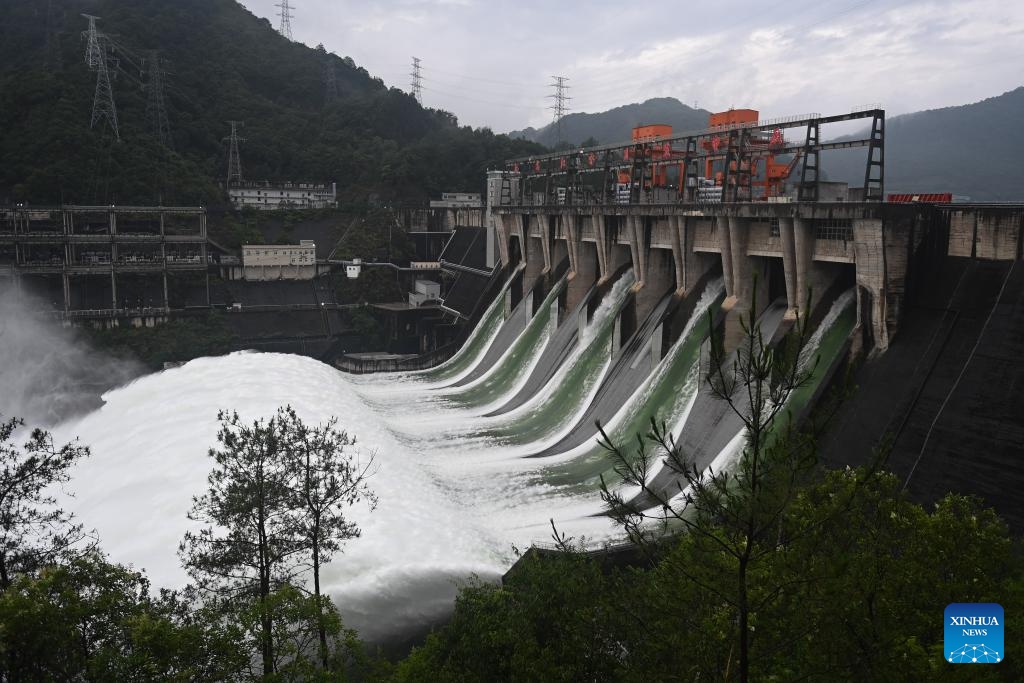
This photo taken on June 24, 2024 shows the Xin'an River Reservoir releasing water for flood control in Jiande City, east China's Zhejiang Province. China's State Flood Control and Drought Relief Headquarters on Monday raised emergency responses to flooding to Level III in the eastern province of Zhejiang.(Photo: Xinhua)
Southern China has been buffeted by days of torrential downpours, deadly flash floods and major landslides that have forced authorities to step up emergency plans and countermeasures to minimize casualties and economic loss, as waterlogging and surging waters from swollen rivers forced the evacuation of tens of thousands of people and disrupted the lives of millions.
China's National Meteorological Center (NMC) issued a rainstorm red alert, the highest level, for a second consecutive day on Tuesday morning, forecasting heavy rainfalls, torrential downpours and thunderstorm-level gales in eight provincial-level regions across the southern areas of China including parts of Southwest China's Sichuan Province and Chongqing Municipality, Central China's Hubei and Hunan Provinces and East China's Anhui, Jiangxi and Zhejiang Provinces from Tuesday to Thursday.
Since mid-June, the middle and lower reaches of the Yangtze River have been hit by consistent torrential rainstorms with the accumulated precipitation in some provinces such as Anhui, Jiangxi and Hunan so far reaching 500 millimeters and then some. Changde city in Hunan and Huangshan city in Anhui, in particular, have seen amounts up to 740 millimeters.
It is estimated that parts of the northern area of Jiangxi will be hit by rainstorms with precipitation of 260 millimeters from Tuesday morning to Wednesday morning, while some parts of the provinces of Anhui, Hunan and Zhejiang will be hit by heavy rains with maximum hourly rainfall of over 70 millimeters.
Chen Tao, chief forecaster for the National Meteorological Center, said during a press briefing on Monday that the areas affected by this round of rainfall overlap with the areas affected by previous storms, which constitutes a high volume of precipitation and a notable cumulative effect. The latest precipitation may result in a high likelihood of disasters.
Due to the impact of the rainstorms, a total of 24 counties and districts in five cities, such as Huangshan and Xuancheng in Anhui, have been affected by disasters, with 105,000 people undergoing emergency relocation and a total of 597,000 people affected across the province as of Monday afternoon.
According to statistics from the provincial emergency management department in Jiangxi, floods and geological disasters that began on Saturday had affected 85,000 people in 22 counties, districts and functional areas across four cities, with 1,397 people undergoing emergency relocated and 538 people resettled as of Monday afternoon, causing direct economic losses of 69.32 million yuan ($9.55 million).
In Hunan, the total accumulated precipitation in the province has amounted to 688.4 millimeters since the start of the flood season, which is 29.5 percent more than the average for this period and the largest amount for the same period since 1961. Particularly, since June 16, a total of 597,300 people from 85 counties and districts in 14 cities have been affected by rainstorms that have caused direct economic losses of 1.18 billion yuan.
China's State Flood Control and Drought Relief Headquarters upgraded the emergency response for Zhejiang, Anhui, Jiangxi and Hunan to Level III on Monday and had dispatched working groups to guide flood control and disaster relief efforts.
In Zhejiang, the Xinanjiang Reservoir had opened seven floodgates and the Fuchunjiang Reservoir had opened 17 floodgates to discharge flood waters as of Monday night.
In Anhui, the Department of Natural Resources of Anhui Province and the Anhui Meteorological Service jointly issued the province's first red alert for geological disasters on Monday. According to Wang Chao, director of the flood control and drought relief headquarters of the provincial emergency management department, the authority vows to ensure the prompt and early relocation of people threatened by mountain floods and geological disasters, and anticipate and coordinate the deployment of rescue forces across regions to guarantee timely rescue and disaster relief operations.
In Jiangxi, 688 meteorological stations in 38 counties and districts recorded torrential downpours between Monday morning and Tuesday morning, with the maximum precipitation of 217.1 millimeters occurring at a station in Yichun city.
The provincial flood control and drought relief headquarters activated a Level-III emergency response for flood control on Monday evening, as the water levels of multiple reservoirs in Yifeng county, Yichun city, had been rapidly rising and exceeding warning levels.
Yifeng has so far prepared various emergency rescue equipment and sufficient relief supplies, with 2,000 people organized into 21 flood control and emergency rescue teams on standby to ensure the security of people's lives and property, the Global Times learned from the county's emergency management bureau on Tuesday.
In the Yangtze River Delta region, operation of some sections of railway lines were suspended on Tuesday and Wednesday, as local weather departments had forecast continuous heavy rain between Monday and Thursday. China Railway Shanghai Bureau Group Co, which operates the railways in the region, said that all the sold tickets for suspended lines can be refunded within one month with no attached service fees.
Additionally, public transportation such as 64 bus lines in Nanchang, Jiangxi, and the ferry services in Hangzhou, Zhejiang, were both suspended on Monday due to the rainstorms.




